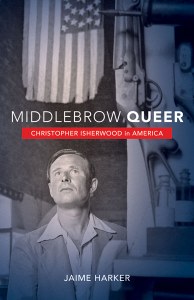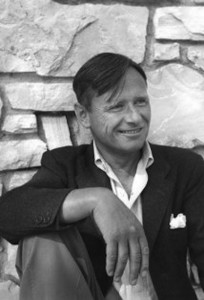 Middlebrow Queer: Christopher Isherwood in America
Middlebrow Queer: Christopher Isherwood in America
by Jaime Harker
University of Minnesota Press. 216 pages, $22.50
IN RECENT YEARS, Christopher Isherwood’s presence in popular culture has been on the rise, what with the film documentary Chris and Don: A Love Story (2008), Tom Ford’s film adaptation of A Single Man (2009), and the BBC’s adaptation of Isherwood’s autobiography, Christopher and His Kind (2010). The University of Minnesota Press has released four books in the 2000s related to Isherwood: his autobiography, Lions and Shadows (2000); Lisa Colletta’s edition of letters between Isherwood and his mother, Kathleen and Christopher (2005); the collection Isherwood on Writing: The Lectures in California (2007); and, last February, Jaime Harker’s Middlebrow Queer: Christopher Isherwood in America.
In her introduction to the latter book, Harker observes that much Isherwood scholarship focuses on his place in the modernist canon and on his homosexuality.
Her goal is to build upon but challenge this line of research: “Middlebrow Queer constructs a different literary genealogy, one that doesn’t assume traditional notions of cultural capital and literary merit but articulates different standards to assess style, value, and cultural significance”—standards that allow in a wider range of works than in the conventional “highbrow” canon.

Harker explains that “middlebrow” was originally a pejorative term that emerged at around the time that Isherwood was just beginning his work as a writer. The term could indicate writing that was mediocre, melodramatic, feminine, sentimental, or bourgeois. Harker argues that “middlebrow” should be seen as a mode of authorship that prizes identification, emotion, and a symbiotic relationship between reader and writer. Middlebrow complicates and destabilizes the æsthetic hierarchies assumed by modern criticism, allowing for a broader exploration into the diverse American literary cultures, “including the complex negotiations and æsthetic exuberances of Cold War print culture.”
Of particular interest is Harker’s exploration of literary production and consumption in the U.S. during the Cold War, especially queer literary culture. She focuses on the gay protest novel and its relationship to the difficult-to-define concept of “camp”; on pulp paperbacks and queer readership; on the literature of the 1960s and what Harker terms “camp middlebrow”; and on texts produced during the gay liberation era. She traces the portrayal of gays from “the American boys next door in postwar gay protest novels” to their portrayal as a kind of antihero, indicative of a larger cultural despair in the ’60s. In her investigation of the gay liberation movement after Stonewall, particularly print culture, she considers how the mainstream culture both bolstered and benefited from an expansive gay literary culture. Here she takes special note of Isherwood’s changing style as he shifted from fiction to memoir. (It was in his 1971 memoir Kathleen and Frank that he came out as gay.)
Beyond its contribution to the literature on Isherwood, this book seeks to expand the domain of literary queer theory beyond its focus on experimental æsthetics. Harker remarks that, just as the term “queer” stood opposed to “the regime of normal,” queer theory actually began to construct its own regime of the normal, often dismissing more “mainstream” gay texts. The result has been a severe limitation in what literary studies can be. She credits Eve Kosofsky Sedgwick’s Epistemology of the Closet for queer literary scholars’ preference for formally experimental texts that were seen as encoded or closeted. Harker argues that there can be “an æsthetics of accessibility” that is just as worthy of our attention as are more experimental works. Middlebrow Queer contributes to and calls for an expanded, more nuanced investigation of literary culture in the age of Isherwood.
________________________________________________________
Douglas Ray. author of He Will Laugh (Lethe Press, 2012), is writer-in-residence at Indian Springs School in Birmingham, Alabama.





